Ask Ethan: Are galaxies without dark matter actually real?
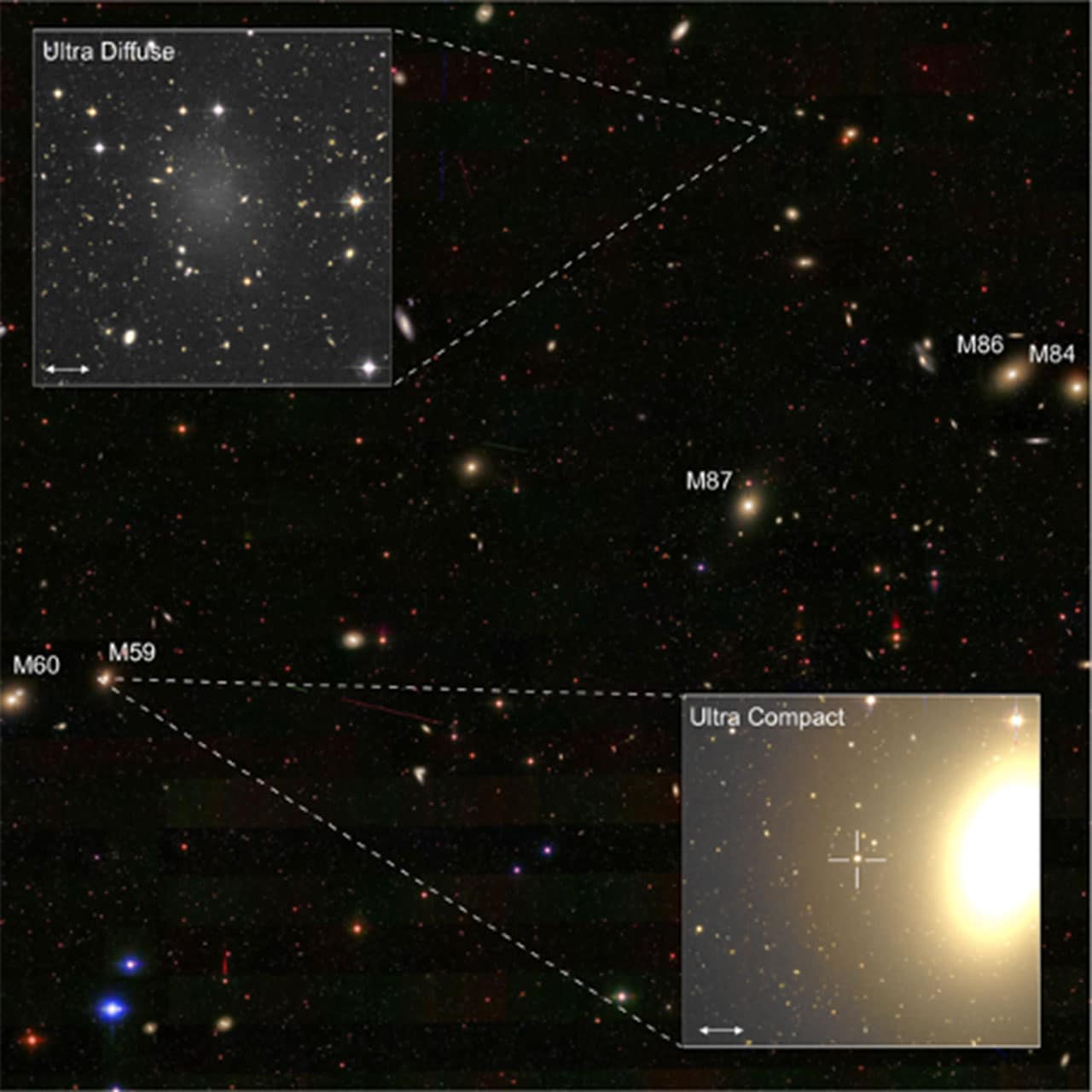
- Across almost every scale in the Universe, from tiny galaxies to the largest cosmic scales, everywhere there’s normal matter, there’s dark matter, too.
- But one class of galaxies, the ultra-diffuse galaxies, don’t display the same properties, with at least some of them appearing not to require dark matter at all.
- The existence of dark matter-free galaxies would all but prove dark matter’s existence, and the evidence is now impossible to ignore.
When we look out at the Universe, what we see is most certainly not what we get. The overwhelming majority of the Universe, for a variety of reasons, is invisible to us, and not in an intuitive sense. Most of the matter we can see — the luminous matter — comes in the form of stars, but that only accounts for a few percent of the normal, atom-based matter that’s out there. Most of the mass in the Universe, as inferred from its cumulative gravitational effects, cannot even be normal matter, but rather must be some novel type of invisible matter: dark matter, which outmasses normal matter by a 5-to-1 ratio. And beyond that, a full two-thirds of the Universe’s overall energy isn’t matter at all, but rather a novel type of energy that doesn’t clump, cluster, or gravitate in the conventional way: dark energy.
And yet, while most galaxies, including our own, have tremendous amounts of dark matter, there are a few cosmic outliers. Initially, the first couple were disputed, but a recent study claims to have discovered six new ones that have, as best as we can tell, no dark matter at all. Is this, for lack of a better word, real? And if so, what does it mean? That’s what Justin Briggs wants to know, asking:
“Hey, Starts With A Bang, is this [story] as weird as it sounds, or just link bait?”
The story he’s referring to is that of not just one galaxy without dark matter, but six, based on this new peer-reviewed and recently published study. There’s a fascinating amount of science here, so let’s dive in to show you what it’s all about.

Credit: Ingo Berg/Wikimedia Commons; Acknowledgement: E. Siegel
There’s an overwhelming amount of astrophysical evidence — albeit indirect evidence — supporting the existence of dark matter in the Universe. To briefly recap:
- We have a large suite of cosmic data — like the cosmic microwave background, the large-scale structure of the Universe, and the redshift-distance relation — that teaches us that approximately one-third of the Universe’s total energy is in the form of matter.
- Only about ~5% of the Universe’s total energy is allowed to be in the form of normal, atom-based matter, as confirmed through the abundances of the light elements prior to the formation of any stars.
Additionally, we see that normal matter alone cannot explain the motions of:
- stars within individual galaxies
- gas clouds on the outskirts of galaxies
- individual galaxies within gravitationally bound galaxy clusters
- peculiar velocities of galaxy pairs
On top of that, we also have evidence of dark matter from gravitational lensing, including, most strikingly, from colliding galaxy clusters, which shows that there is plenty of gravitating mass where the normal matter is not.

Credit: NASA, ESA, D. Harvey (École Polytechnique Fédérale de Lausanne, Switzerland; University of Edinburgh, UK), R. Massey (Durham University, UK), T. Kitching (University College London, UK), and A. Taylor and E. Tittley (University of Edinburgh, UK)
And yet, all of these observations, a puzzle to explain on their own, immediately fall into line with a single, compelling, and self-consistent story if we add one ingredient to the Universe: a form of massive matter that clumps, gravitates, and moves slowly compared to the speed of light, in about five times the abundance of normal matter. We call this dark matter, though it’s not actually “dark;” dark things absorb light and don’t emit any, while this form of matter is actually invisible, not interacting with light or colliding with normal matter (or itself) in any discernible way.
When we examine the details of the cosmic web, and how the galaxies form and evolve within it, again, dark matter is absolutely required. But there’s a longstanding prediction that had, for many years, puzzled theorists and observers alike. You see, if dark matter exists, then every massive clump in the Universe, when it first forms, should consist of both dark matter and normal matter in approximately the same ratio as the overall, cosmic one: about a 5-to-1 ratio. As the Universe evolves, however, things get messy.
Normal matter collides inelastically, contracts, sheds momentum and angular momentum, and forms stars. Radiation from new stars push the normal matter outwards, but not the dark matter. Proto-galaxies gravitationally interact; normal matter gets stripped from fast-moving galaxies in gas-rich environments; mergers occur; etc.
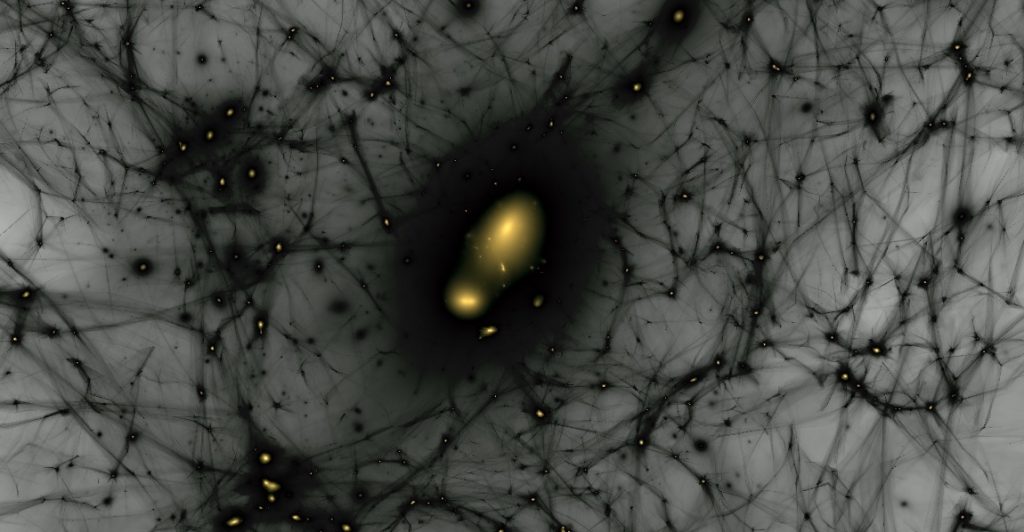
Credit: Ralf Kaehler/SLAC National Accelerator Laboratory
As a result of all of this, we expect three sets of galactic populations:
- Large, massive galaxies, with the same overall dark matter-to-normal matter ratio as the overall cosmos and the largest structures of all: approximately 5 to 1.
- Small, less massive galaxies, where things like star formation have previously occurred, expelling much of the normal matter. These galaxies are expected to have greater dark matter-to-normal matter ratios than the cosmic average, where the smallest, lowest-mass examples might have ratios of hundreds-to-1 or even more extreme.
- A rare population of galaxies that form from the normal matter that gets stripped out of their dark matter halos entirely: dark matter-poor or even dark matter-free galaxies, where the dark matter-to-normal matter ratio is far less than 5 to 1, and may even be as low as zero in some galaxies.
For a long time, only the first two types of galaxies had been seen. Moreover, the second population of galaxies appeared to obey a relatively tight correlation: the baryonic Tully-Fisher relation, where only the normal matter component of galaxies was necessary for predicting their behavior, regardless of overall mass or the underlying, assumed dark matter ratios.
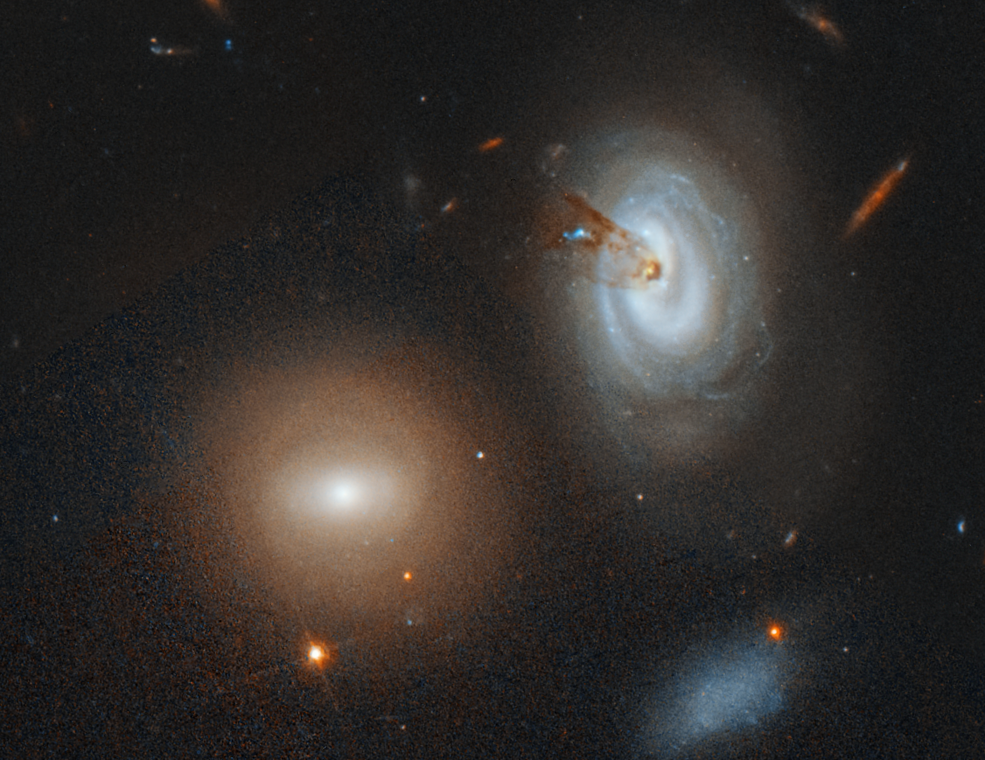
Credit: NASA, ESA, M. Sun (University of Alabama), and W. Cramer and J. Kenney (Yale University)
Detractors of dark matter pointed to this as evidence that the dark matter paradigm must be incorrect, but most researchers had a different take on it. Either these galaxies were out there but faint and difficult to characterize, or that most of them formed close by other large, massive galaxies, which would tear them apart on timescales that were short relative to the age of the Universe.
One of the remarkable things about these scenarios is that they’re extremely different from one another, and that lends itself to an observational test. If dark matter is incorrect as a paradigm overall, then the properties of each galaxy should be determined by the presence, abundance, and distribution of normal matter alone. On the other hand, if dark matter exists, then we should be able to search for two classes of galaxies that hasn’t been identified before. If they exist, they would support the existence of dark matter in the cosmos; if not, their absence would call the viewpoint that the Universe contains ample amounts of dark matter into question, justifying the doubts put forth by the contrarians in the community.

Credit: S. Danieli et al., ApJL, 2019
One population of galaxies that ought to exist would be small, diffuse satellite galaxies found in the vicinities of larger ones. These galaxies should be relatively short-lived, so we should be able to witness them being destroyed through tidal, gravitational interactions from the outside looking inward. These galaxies would be faint and low in both overall mass and overall brightness, so we’d have to search the local neighborhood very carefully to make sure we’re finding and characterizing them properly. Moreover, we might even be able to find stellar streams emanating from these galaxies: evidence that they’re in the process of being tidally torn apart.
The second population that ought to exist would be larger, more massive, but relatively isolated galaxies that had their dark matter stripped away long ago. These galaxies should also be rare, but since there are many types of interactions that can separate normal matter from dark matter, it’s reasonable to expect that some of that normal matter will remain clumped together and gravitationally bound. Over time, if it were sufficiently isolated from other massive objects, it could persist, leading to a new population of field galaxies that were faint, diffuse, and nearly completely devoid of dark matter.
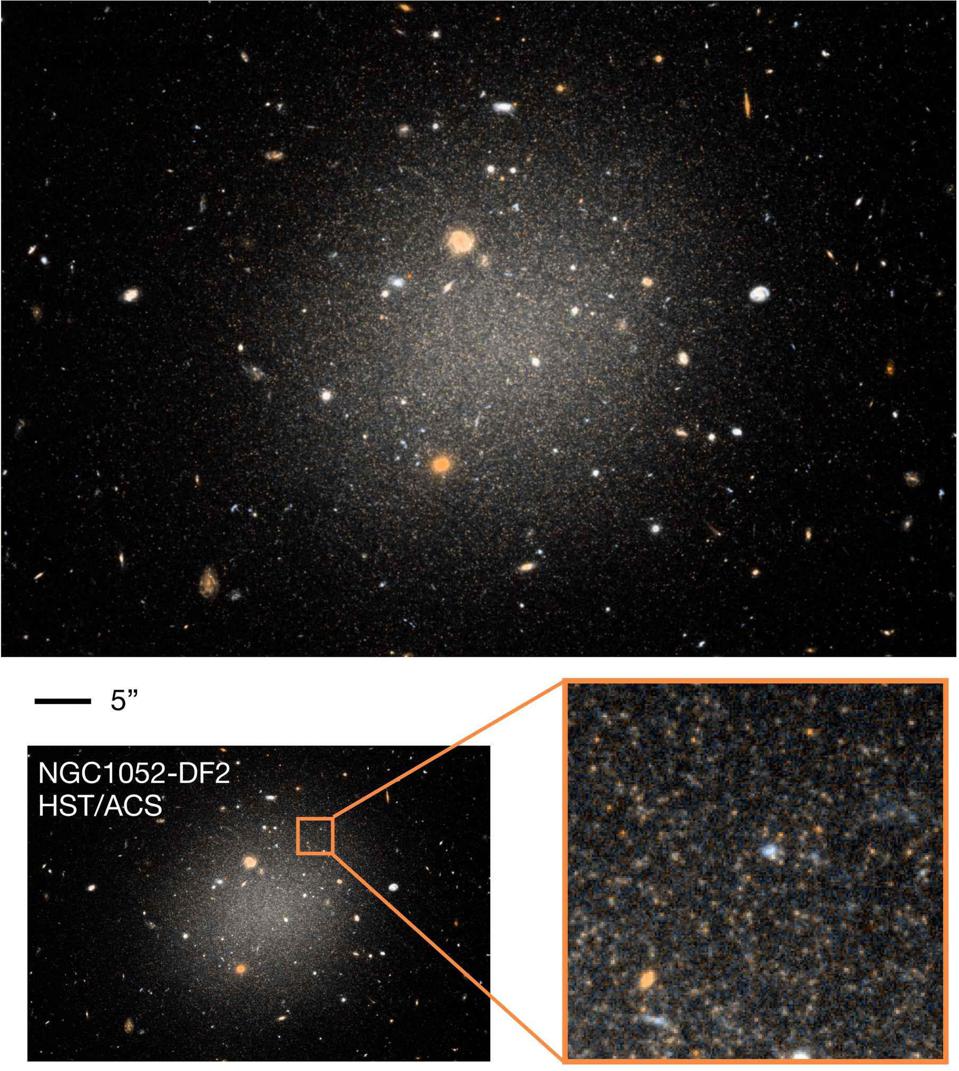
Credit: Z. Shen et al., ApJ, 2021
Only a few years ago, the first two examples of candidate galaxies that fell into the first category were discovered. (Or more accurately, since they were previously known, they were characterized.) There’s a region of the sky that possesses three relatively large, massive galaxies: NGC 1052, NGC 1042, and NGC 1035, all well-separated from one another. While searching for galaxies using the Dragonfly Telephoto Array, a team led by Shany Danieli and Pieter van Dokkum of Yale discovered and characterized a number of small satellite galaxies that appeared to be bound to NGC 1052, a large elliptical galaxy. Importantly, two of them were ultra-diffuse dwarf galaxies, and they appeared to lack the dark matter expected to be found within them. Dubbed NGC 1052-DF2, discovered in 2018, and NGC 1052-DF4, found the next year in 2019, they immediately set off a firestorm of research.
Could these galaxies be explained with MOdified Newtonian Dynamics instead of as a galaxy lacking dark matter? Were we measuring the distance to the dwarf galaxies incorrectly? Were they actually associated with one of the other galaxies located nearly along the same line of sight: NGC 1042 or NGC 1035? Could the host galaxy, NGC 1052, actually be deficient in dark matter?
As follow-up observations with a superior instrument — the Hubble Space Telescope — showed, the answer to all of these questions is “no.” The velocity dispersion is too low and the distance to these galaxies is too great; they really do have slow-moving stars and extremely small, and possibly no, dark matter inside.
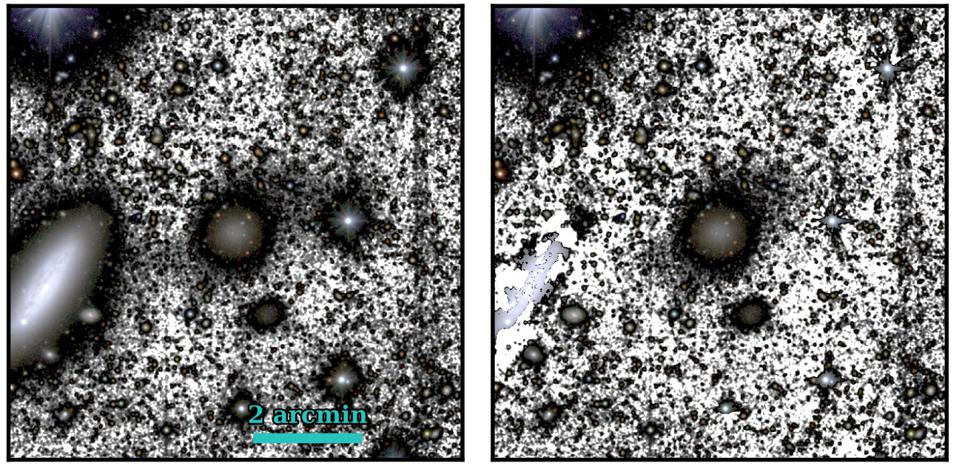
Credit: M. Montes et al., ApJ, 2020
Additionally, one of these galaxies, NGC 1052-DF4, is presently undergoing tidal disruption: evidence that the gravitational forces from the larger, more massive, surrounding galaxies are in the process of tearing it apart. It’s being sheared and shredded apart from the outside in, which means that the most tenuously held outer parts are getting ejected first. As the galaxy loses its mass, it evolved to become more diffuse, and then even the stellar components start to get ejected in tidal streams. The fact that a small tidal stream has now been observed could be a hint: perhaps these galaxies are only dark matter-free right now; perhaps earlier, they had “normal” amounts of dark matter, and perhaps in the future, they’ll be torn apart entirely.
But what about that second population of expected galaxies: the larger, more massive ones without dark matter that could persist if they’re sufficiently isolated from other large, massive galaxies?
That is — to go way back to the original question — where the new study being touted in the popular media comes into play. Led by Pavel E. Mancera Piña and published in the Astrophysical Journal Letters back in 2019 (honestly, I have no idea why it’s suddenly popular now?), they identify six independent galaxies, all sufficiently isolated from others, with large reservoirs of neutral hydrogen gas. They’re all diffuse, massive, and, most importantly, their stars move with very, very slow internal motions, consistent with having no dark matter inside at all.
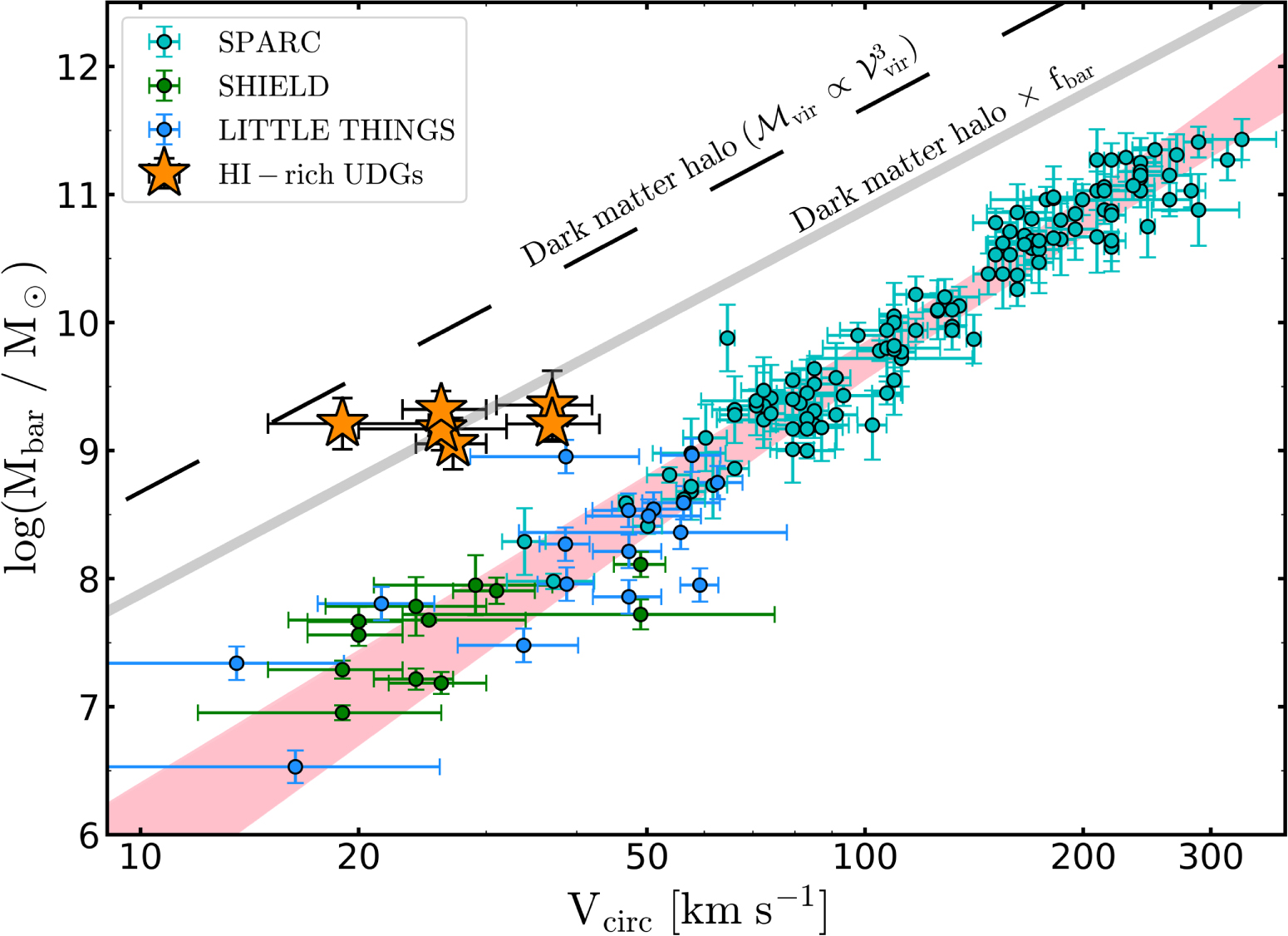
Credit: P.E. Mancera Piña et al., ApJL, 2019
This is, if it holds up, absolutely groundbreaking. Each of the six galaxies, on the whole, are all:
- around 300 million light-years away
- rich in neutral hydrogen gas, with over a billion solar masses of that gas in each galaxy
- have their stars orbiting very slowly around the center; about one-tenth the speed of the stars in the Milky Way
- have no detectable neighboring galaxies within more than a million light-years (~350 kpc) of each one
The methods used by the authors of the paper are completely standard in the field. None of them are either edge-on or face-on, eliminating a potential systematic error, and three additional galaxies that also show the same effect were excluded from this study because the data on them were not as pristine.
In other words, these are gold-standard detections, and they fly in the face of a number of dark matter alternatives. Perhaps most importantly, when you take these six dark matter-free galaxies and you look at them alongside NGC 1052-DF2 and NGC 1052-DF4 (commonly shortened to DF2 and DF4 in the literature), you can see that both populations of galaxies are consistent with containing no dark matter, and with one another.
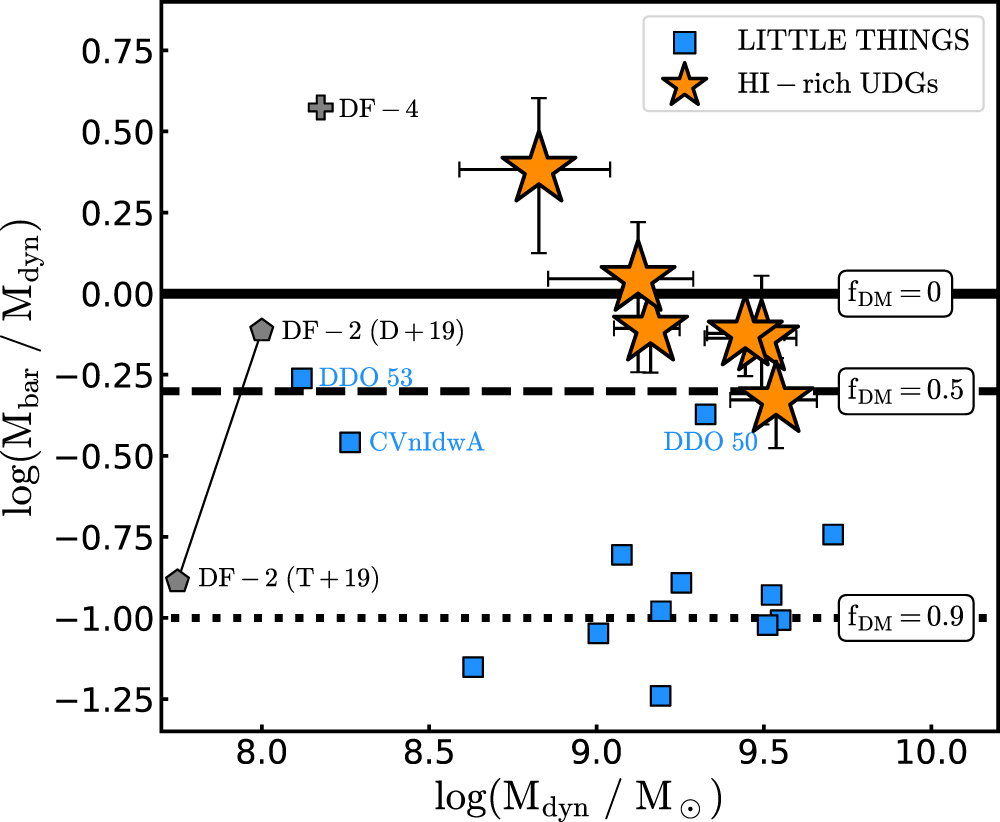
Scientists, you must understand, are a notoriously skeptical bunch. Convincing the overwhelming majority of any subfield of science that things are one particular way only occurs when the supporting evidence is also overwhelming. Although the astrophysical evidence in favor of dark matter reached that point long ago, we must always remember that continually testing our assumptions and gathering more and improved data about the Universe is the only way by which science can continue to advance. As soon as we’ve decided that we already know all there is to know, we’re right. The moment we stop asking questions and investigating the apparent gaps in our understanding is the moment we’ve lost the opportunity to uncover anything new.
Those who attempt to explain the Universe without dark matter now have an additional obstacle to contend with: a prediction of dark matter that had long gone unverified, that galaxies explicable by their normal matter alone should exist, has finally come to fruition. Not only that, but both types of such galaxies predicted to exist — satellite galaxies that won’t live for long, and major galaxies that can persist for billions of years in isolation — have now been found, with multiple examples of each. It’s a beautiful success story for dark matter, and one more piece of the cosmic puzzle that appears to have fallen neatly into place.
Send in your Ask Ethan questions to startswithabang at gmail dot com!





